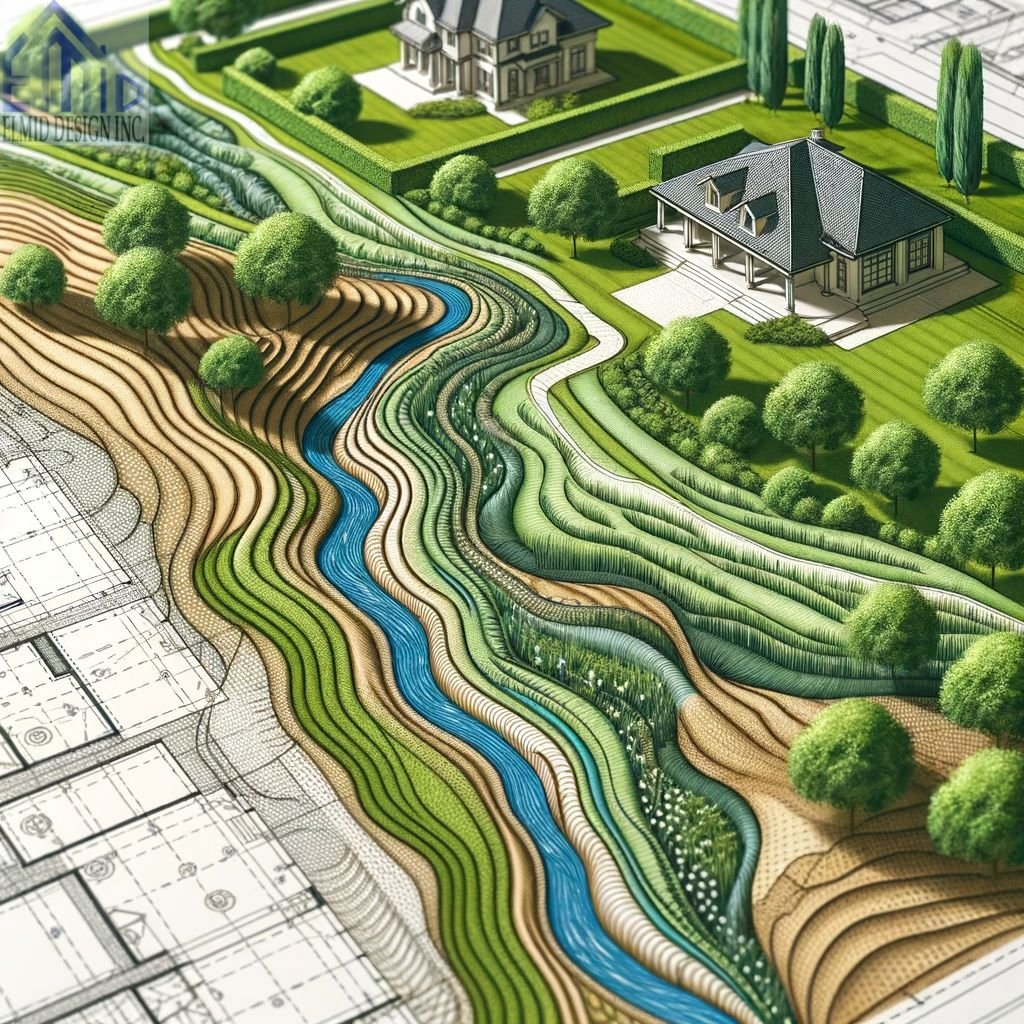Introduction: Understanding Lot Grading Plans
Lot grading plans are crucial blueprints in urban planning and construction. They outline how land should be shaped and contoured to manage water flow and drainage, ensuring stability and preventing potential damage from water accumulation. This protects structures and plays a pivotal role in maintaining the area’s ecological balance. A well-conceived lot grading plan is the foundation of sound urban development for residential, commercial, or public projects.
Table of Contents
The Role of Lot Grading Plans in Construction and Urban Development
Lot grading plans are more than just construction blueprints; they’re critical to sustainable urban development. Controlling how water interacts with the landscape, these plans help prevent soil erosion, flooding, and water damage to buildings. Their role extends beyond individual properties to the broader urban ecosystem, impacting everything from stormwater management to preserving natural habitats.
Requirements and Standards for Lot Grading Plans: A Look at Different Cities
City of Richmond Hill
Richmond Hill sets specific standards for lot grading, encompassing grading and drainage requirements essential for any construction project. These standards ensure that developments align with the city’s broader urban planning objectives, focusing on sustainable and effective water management. Richmond Hill Grading and Local Drainage
City of Toronto
Toronto’s approach to lot grading in new housing projects emphasizes the owner’s responsibility to retain experienced grading consultants. The city’s criteria are designed to prevent new construction from negatively impacting existing drainage patterns and neighboring properties.
Elmid Design Inc: Engineering Excellence in Lot Grading Plans
Elmid Design Inc, certified by Professional Engineers Ontario (PEO), exemplifies engineering excellence in lot grading. Their comprehensive approach to lot grading encompasses all facets of a project, ensuring compliance with municipal standards and enhancing the functionality and aesthetics of the landscape. The company’s track record in delivering effective lot grading plans speaks to their proficiency and commitment to quality. Mastering Grading Plans in Georgina, Elmid Design Grading Plans in Oakville, Grading and Drainage Plan for Construction, Grading Plans in the Greater Toronto Area, Grading Plan Services in Vaughan
Implementing a Successful Lot Grading Plans
Developing a successful lot grading plan starts with an in-depth site analysis, considering topography, soil type, and natural water movement. This step is essential to grasp the land’s unique features.
In the design phase, experts like engineers and urban planners leverage their skills. They tailor a plan to fit both regulatory standards and project-specific needs. This plan outlines land shaping, slope creation, and the integration of drainage features.
The implementation phase brings the plan to life. It requires detailed coordination among construction teams to ensure accurate execution. Regular monitoring and adjustments might be necessary as work progresses.
After completing the grading work, an inspection confirms that the grading meets the design and effectively manages water flow. A well-executed plan offers lasting benefits for property sustainability and integrity.
Challenges and Solutions in Lot Grading Plans
Lot grading challenges include handling diverse land contours and environmental conditions. Innovative design and engineering are key to addressing these issues, especially in areas with unique drainage needs.
Managing the impact on surrounding properties is also crucial. Grading plans must ensure that neighboring lands aren’t negatively affected, directing water to appropriate outlets.
Navigating environmental regulations and local laws is another hurdle. Collaborating with local authorities during the planning phase ensures compliance and facilitates the approval process.
Erosion control during and post-construction is vital. Implementing silt fences and temporary swales is essential to maintain soil integrity and prevent erosion, especially during inclement weather.
The Evolution of Lot Grading Plans in Urban Planning
Lot grading has evolved significantly over the years. Initially, it was a rudimentary practice focused mainly on preventing water from entering buildings. However, as urban areas expanded, the role of lot grading grew more complex and vital. Today, it addresses water management and contributes to urban aesthetics, environmental sustainability, and infrastructure longevity.
Urban planners and engineers now consider lot grading as a critical element in sustainable urban design. Innovations in technology and design have allowed for more precise and effective grading plans. These advancements have led to better stormwater management, reduced erosion, and enhanced aesthetic appeal of landscapes.
The Interplay between Lot Grading Plans and Environmental Sustainability
Sustainable lot grading goes beyond mere water management. It plays a significant role in preserving natural habitats and biodiversity. By carefully designing the way water flows through a landscape, urban planners can minimize the impact on local ecosystems.
Incorporating green infrastructure, like rain gardens and permeable pavements, into lot grading plans is becoming increasingly popular. These elements manage stormwater and contribute to urban green spaces, supporting local flora and fauna.
The Role of Technology in Modern Lot Grading Plans
The use of technology in lot grading has brought about significant improvements. Geographic Information Systems (GIS), 3D modeling, CAD and drone surveying have revolutionized how planners and engineers approach grading. These tools provide a detailed understanding of the terrain, allowing for more accurate and efficient designs.
Moreover, technology enables better communication and collaboration among various stakeholders in a construction project. It ensures all parties are on the same page, reducing errors and misunderstandings during the implementation phase.
The Future of Lot Grading in Urban Development
The future of lot grading in urban development is promising, emphasizing more integrated and sustainable approaches. As cities grow and face environmental challenges, the importance of well-designed lot grading plans will only increase.
Emerging trends suggest a greater focus on climate resilience. This means designing grading plans that can adapt to changing weather patterns and mitigate the effects of extreme weather events. Additionally, integrating smart city concepts into lot grading, like IoT-based water management systems, will likely become more prevalent.
Geographic Locations That We Service:
Our Licensed Professional Engineers specializing in Engineered Site Grading Plans offer the best-engineered site grading plan, lot grading plan, and drainage plan to obtain site plan approval and building permits in Ontario, including a wide range of municipalities. Each area boasts unique features and requirements, making our tailored approach essential for success.
Toronto and Surrounding Areas
In the vibrant heart of Ontario, we service Toronto (City of Toronto) and surrounding areas. Additionally, we cover Oshawa (City of Oshawa), Pickering (City of Pickering), and Clarington (Municipality of Clarington). Furthermore, our expertise extends to Ajax (Town of Ajax), Whitby (Town of Whitby), Brock (Township of Brock), Scugog (Township of Scugog), and Uxbridge (Township of Uxbridge).
Halton Region
Moving to the Halton Region, our services encompass Burlington (City of Burlington) and Halton Hills (Town of Halton Hills). Also included are Milton (Town of Milton) and Oakville (Town of Oakville).
Peel Region
In the Peel Region, we provide services in Brampton (City of Brampton), Mississauga (City of Mississauga), and Caledon (Town of Caledon).
York Region
Our services in the York Region cover Vaughan (City of Vaughan), Aurora (Town of Aurora), and East Gwillimbury (Town of East Gwillimbury). We also cater to Georgina (Town of Georgina), Markham (City of Markham), Newmarket (Town of Newmarket), Richmond Hill (City of Richmond Hill), Whitchurch-Stouffville (Town of Whitchurch-Stouffville), King (Township of King), and Bradford-West Gwillimbury (Town of Bradford-West Gwillimbury). Each municipality here offers a distinct setting, requiring our specialized approach.
Other Southern Ontario Cities and Towns
We also serve many other cities and towns in Southern Ontario. These include Hamilton (City of Hamilton), St. Catharines (City of St. Catharines), Niagara on the Lake (Town of Niagara on the Lake), Brant (County of Brant), Cambridge (City of Cambridge), Kitchener (City of Kitchener), Waterloo (City of Waterloo), and Woodstock (City of Woodstock). Furthermore, we operate in Guelph (City of Guelph), Centre Wellington (Township of Centre Wellington), Shelburne (Town of Shelburne), Orangeville (Town of Orangeville), New Tecumseth (Town of New Tecumseth), Essa (Town of Essa), Collingwood (Town of Collingwood), Wasaga Beach (Town of Wasaga Beach), Barrie (City of Barrie), Midland (Town of Midland), Orillia (City of Orillia), Ramara (Town of Ramara), Minden Hills (Town of Minden Hills), North Kawartha (Town of North Kawartha), Kawartha Lakes (City of Kawartha Lakes), Peterborough (City of Peterborough), Selwyn (Town of Selwyn), and Brighton (Municipality of Brighton).
FAQs
- What is a lot grading plan? A lot grading plan is a blueprint for shaping land to manage water drainage and prevent soil erosion.
- Who can create a lot grading plan? Certified professionals, like those at Elmid Design Inc, should create the grading plans.
- What is grading in planning? In urban and construction planning, grading refers to the leveling or shaping the ground to prepare it for construction. It’s a crucial step in ensuring the area has proper drainage and structural integrity. Grading considers the natural landscape and how alterations can harmoniously integrate with it.
- What is the difference between a grading plan and a site plan? While grading and site plans are fundamental in construction projects, they serve different purposes. A grading plan focuses on the land’s contours, detailing how the site will be shaped for drainage and stability. On the other hand, a site plan provides a broader overview, including the layout of buildings, driveways, landscaping, and other features. The grading plan is a component of the larger site plan, specifically with topographical aspects.
We'd love to hear from you
Get in touch with us
Tell us about yourself by completing the form below. Your information is always kept confidential.
Reach us through
-
13025 Yonge St, Unit # 201G, Richmond Hill, ON, L4E 1A5 - +1 647 745 4507
- info@elmid.ca
Send us a Message







